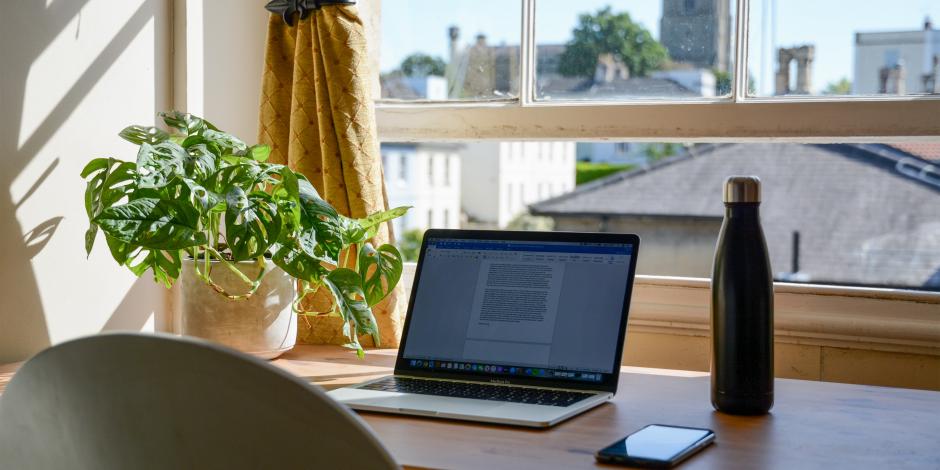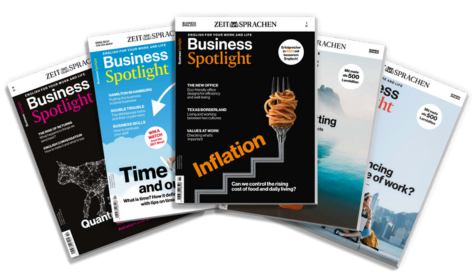Before Covid, employees were likely to spend no more than one day a week working from home. Now, it’s more likely to be one or two days in the office. The workplace is now hybridhier: Mischform (aus Büro und Homeoffice)hybrid, but how do we make sure it’s a a level playing fieldgleiche Bedingungenlevel playing field for everyone?
“If you’re in the office every day, you see snippetSchnipsel; hier: Ausschnittsnippets of people’s lives. You see how they receive personal news. Or just how they make their tea or wash their cup,” says Maritsa Inglessis. She’s an HR consultantPersonalberater(in)HR consultant who left her office job in London just before the pandemic to live and work from Kefalonia, in Greece. “All of this tells us something about our colleagues that you wouldn’t necessarily see on a Zoom call.”
Moments of connection are important for the collaborationZusammenarbeitcollaboration, creativity and inclusion that successful teams need. Companies must find ways for employees to connect even when they’re not all in the same place.
According to a 2021 McKinsey surveyUmfragesurvey, nine out of ten organizations plan to combine remotestandortfern, nicht vom Büro ausremote and on-sitevor Orton-site working in the post-pandemic world. What started as a huge, unplanned experiment, has produced many positive results. Employees enjoy the flexibility of hybrid work, better work-life balance and reduced stress from commutingPendelncommuting, while the chance to save costs on office space is attractive for employers.
Bringing your whole self to work
The McKinsey survey also showed the importance of connection. It found that organizations that supported “small moments of engagementEinbildungengagement” among employees had the biggest productivity increases during the pandemic. “It’s important to create ‘water coolerWasserspenderwater-cooler moments’, like a virtual coffee break, and make sure you to schedule in timeZeit einplanenschedule in time for non-work chat,” says Inglessis, who also recommends having in-personpersönlich; hier auch: Präsenzin-person events several times a year, if possible.
Why is this important? “People need to know that their leader sees the person behind the work — and they want to be able to bring their whole authentic selves to work,” she says. “Plus, if we want people to be engaged, they need to know that they aren’t working for some ‘faceless’ organization.”
Janine Lechermann is helping to establish just such an inclusive workplace. She is one of PR Report magazine’s “30 under 30” talents and a seniorleitendsenior communications specialist at Siemens. In her experience, connection helps companies deal with the transformation we’re seeing in the world. “I find it hard to brainstorm alone,” she says. “Creativity is one of the top skills we need to succeed in our digital world. But how do you transfer the creativity to process sth.etw. verarbeitenprocess to a digital environmentUmgebung, Umfeldenvironment?”
Tips for better online meetings
• Include infotainment elements such as poll(Meinungs-)Umfragepolls, quizzes and word clouds.
• Add variety to longer meetings with different formats — for example listening sessions, interviews, panel discussionPodiumsdiskussionpanel discussions and live chats.
• to liven sth. upetw. beleben, lebendiger gestaltenLiven up presentations with different media such as videos and infographics.
• Hold sessions in (virtual) breakout room (US) (ifml.)Raum für eine Untergruppebreakout rooms so smaller teams can work together and present their results to the group.
Lechermann has some advice, having co-organized one of the first major online events for her company. “For our event platform, we didn’t to neglect sth.etw. vernachlässigen, außer Acht lassenneglect the personal side. We ran a chat alongside the event and we built a networking platform where people could gather, with virtual avatars meeting on an ‘island’. We held two networking sessions across different time zones for people to meet and chat. Another tip for meetings is to ask fun questions, like: ‘If your moodStimmungmood was a song, what would it be?’ It’s important to have these check-inhier: Einbeziehungcheck-in elements and make people really feel included.”
The risks of a hybrid workplace
Connection among teams doesn’t happen automatically. If it’s not to nurture sth.etw. pflegennurtured, there’s a risk that some employees may get left behind. proximity bias | biasEffekt der räumlichen Nähe | VoreingenommenheitProximity bias is the idea that we unconsciously give better treatment to those who are physically closest to us. This bias existed before the pandemic, of course, but now that remote working is so common, it could have a much greater effect.
According to new researchForschungresearch by Workplace Intelligence and Kahoot!, around six out of ten business leaders say that employees who work in the office are more likely to get to promote sb.jmdn. befördernpromoted and enjoy other advantages, and be seen as harder workers. Future Forum, a research group supported by Slack, also sees proximity bias as a growing danger because it could make racial and gender inequalities worse. In the US, white knowledge workerWissensarbeiter(in)knowledge workers are spending significantly more time in the office than people of colour, women and working mothers.
The psychology behind a hybrid workplace
Claudia Hernández, psychologist and systemic therapist based in Madrid, discusses hybridhier: Mischform (aus Büro und Homeoffice)hybrid working.
What are the psychological reasons for proximity bias?
The human brain is often lazier than we think and uses various cognitive bias | biaskognitive Verzerrung | Voreingenommenheitcognitive biases to save time when processing information. This is usually very practical but can often lead to error. Humans need contact to survive, and physical proximity strengthens the impression of participation in a group or organization — this is where proximity biasEffekt der räumlichen Näheproximity bias comes from. I think we’re starting to get used to the idea of “being present” in a non-physical way, but this is still difficult for our brains.
Does a lack of in-person interaction have a negative effect on connection and well-being?
Physical distancing limits in-person social interactions, and that may reduce a sense of social connection. Studies have shown how important social connection is for well-being. However, in their “World Happiness Report” (University of California, 2021), Okabe-Miyamoto and Lyubomirsky showed that physical distancing isn’t the same as social isolation. They say social connection and loneliness haven’t changed much and, in some cases, might have improved. The worry that physical distancing is preventing connection for most people might be unfoundedunbegründetunfounded. Recent studies suggest that, through the internet and other means, we can be close despite physical distance.
What can be done?
Improving virtual and in-person meetings, as well as using the most up-to-date collaboration technologies, are a good start. But companies can do more.
consistentfolgerichtig, konsequentConsistent processes: Make sure processes around performance management, appraisalBeurteilungappraisals and recognition are the same for everyone. “If you want your people to feel like they’re in a fair workplace, you have to be transparent,” Inglessis says. “Processes provide transparency, and employees know where they stand.”
Trust and open communication: In a remote environment, results are important, not attendance. Lechermann says: “appreciationWertschätzungAppreciation is criticalwesentlich, entscheidendcritical. It says: ‘I don’t see what you’re doing, but I trust you.’ Leaders need to have an interest in their people, and employees need to trust their leader to be honest with them.”
And Inglessis says: “Managers must be explicit regarding their expectations. We have to communicate with real purposehier: Zielgerichtetheitpurpose.” She adds that education (learning new skills and raising awareness of biases) is essential.
Well-being comes first: “One challenge for me is that work never stops — the pressure to be available to take a tollseinen Tribut forderntakes a toll,” Lechermann says. “It’s important to be able to say when you need balance, but bringing these things up takes courage.”
No one size fits all
There’s a fine lineschmaler Gratfine line between having the freedom to work wher–ever and whenever and feeling pressure to be “onhier: onlinealways on”. Inglessis says some people enjoy this freedom while others need more structure. And Lechermann to point sth. outetw. hervorhebenpoints out that we’re still at the beginning of this transformation, in which no one size fits allhier etwa: es gibt keine Patentlösungno one size fits all. Each person needs to find what works best for them. “Keep in mind that no one’s perfect and we’re all still learning,” she says. “My motto is: to sprinkle sth.etw. bestreuen, besprengen; hier: verteilensprinkle kindness like confetti!”
Neugierig auf mehr?
Dann nutzen Sie die Möglichkeit und stellen Sie sich Ihr optimales Abo ganz nach Ihren Wünschen zusammen.



